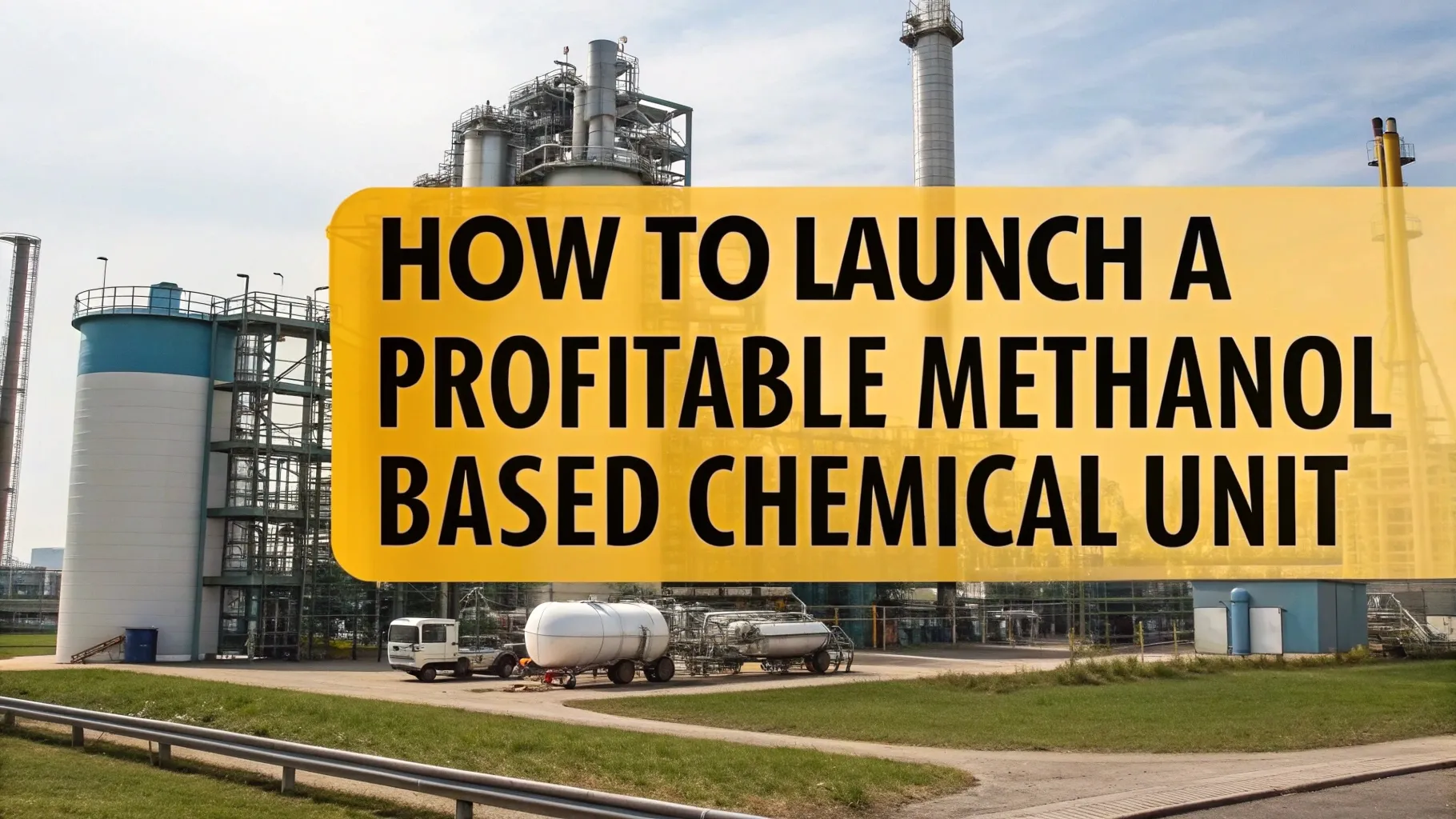India is experiencing a transformative phase in its industrial landscape, driven by sustainability goals, energy independence, and the growing need for chemical intermediates in crucial sectors. Among the rising prospects in this evolving ecosystem, methanol chemical stands out as a chemical of significant strategic value. Not only is methanol remarkably versatile, but it also aligns closely with India’s long-term objectives of clean fuel adoption and reducing reliance on imports.
From applications in transportation and pharmaceuticals to its role as a clean energy alternative, methanol is emerging as a key player across multiple industries. For entrepreneurs and small manufacturers, this trend presents a unique opportunity. The anticipated rise in demand, coupled with favorable government policies, creates an ideal environment for establishing methanol-based chemical units. This guide serves to inform and empower aspiring industrialists by exploring methanol’s potential in India, its practical applications, production processes, and strategies for entering the sector sustainably.
Understanding Methanol and Its Industrial Significance
Methanol, chemically represented as CH?OH, is a clear and colorless liquid that plays a foundational role in the field of chemistry. Known for its clean-burning properties and biodegradability, methanol offers a viable alternative to conventional fossil fuels. Although it is toxic in concentrated forms, methanol’s controlled industrial use makes it a crucial ingredient in numerous chemical applications.
In the Indian industrial context, methanol serves dual purposes: as a chemical feedstock and as an alternative energy source. It is a precursor for several essential chemicals including formaldehyde, acetic acid, methylamines, and dimethyl ether. Additionally, extensive research is ongoing to establish methanol as a sustainable fuel for automotive and industrial heating purposes.
A major concern for India is its dependence on imported methanol. In 2024, it was estimated that over 75% of methanol consumption was met through imports. This heavy reliance is not only economically burdensome due to trade deficits but also risky during global supply chain disruptions. Enhancing domestic methanol production would significantly strengthen the national economy, reduce vulnerabilities, and support energy security.
Related: What Is the Future Outlook for the Indian Speciality Chemical Industry
Market Overview and Industry Outlook (2025–2029)
India’s methanol infrastructure has witnessed substantial improvements over recent years. These developments have paved the way for increased demand across several sectors such as automotive, construction, pharmaceuticals, textiles, and coatings. Between 2025 and 2029, methanol demand is expected to rise sharply, supported by industrial expansion and government-backed initiatives.
Estimated Growth Trajectory
The anticipated demand for methanol in 2025 stands at 4.1 million metric tonnes (MMT). This figure is projected to grow at a compound annual growth rate (CAGR) of over 13% through 2029, reaching approximately 6.7 MMT. The consistent upward trend is driven by its application in fuel substitution, adoption in industrial chemicals, and expanding use in pharmaceuticals and infrastructure-related products. Notably, government support in the form of fuel blending policies and investment in coal and biomass gasification technologies has added to the sector’s viability.
Government programs such as the M15 blending initiative, where 15% methanol is blended with petrol, further enhance the appeal of methanol as an alternative fuel. This, along with various policies aimed at encouraging clean energy adoption, creates a fertile ground for investment in methanol production and distribution.
Key Drivers for Methanol Consumption
The widespread industrial utility of methanol makes it a chemical of high demand. In the petrochemical sector, it is used extensively in the production of formaldehyde, acetic acid, and other derivatives that are foundational to the manufacture of paints, adhesives, and resins. The continued growth of India’s infrastructure and construction sectors fuels this demand.
In the transportation sector, methanol offers a promising solution to reduce dependency on imported fuels. The Indian government’s approval of methanol-blended fuels like M15 indicates a shift towards alternative energy in both private and public transport systems. Additionally, trials involving methanol-based fuel in marine and railway engines show promising results.
Pharmaceutical manufacturing also benefits from methanol through its derivatives such as methylamines, which are essential for producing medications. With India becoming a leading global exporter of pharmaceuticals, methanol’s relevance in this sector is likely to increase.
Methanol’s utility in the energy sector is not limited to blending with gasoline. It can also be converted to dimethyl ether (DME), which serves as a cleaner substitute for LPG. This conversion plays a crucial role in India’s clean energy transition, particularly in rural and semi-urban areas that rely on domestic LPG.
Manufacturing Process Overview of Methanol Production
Establishing a methanol chemical production unit involves careful planning and execution, particularly when it comes to technology selection and production methodology. The most prevalent production route globally is catalytic conversion of synthesis gas (syngas), a mixture of carbon monoxide, carbon dioxide, and hydrogen.
The first stage in this process involves feed preparation. While natural gas is commonly used as the feedstock worldwide, India is exploring alternatives such as coal and biomass. Before entering the reactor, the selected feedstock is cleaned and conditioned to remove impurities.
The next phase is syngas generation. In natural gas setups, steam methane reforming (SMR) is employed, while biomass feedstocks undergo a gasification process. Both routes aim to achieve the right hydrogen-to-carbon monoxide ratio for optimal reaction efficiency.
Once the syngas is prepared, it undergoes methanol synthesis through catalytic conversion using copper-based catalysts. This process occurs under high pressure and moderate temperature. The resulting crude methanol contains various by-products that must be separated.
Purification and distillation follow, where methanol is separated from water and impurities to achieve high purity standards. The final product is stored in pressurized tanks and made available for shipment in bulk or smaller containers, depending on market needs.
For more information check our project report
Environmental and Sustainability Considerations
Methanol is recognized as a cleaner alternative to fossil fuels. Its use in combustion engines and industrial boilers significantly reduces emissions of nitrogen oxides (NOx), sulfur oxides (SOx), and particulate matter. This makes methanol a valuable contributor to India’s environmental and public health goals.
Innovations such as green methanol—produced using renewable hydrogen and captured CO?—further enhance methanol’s sustainability profile. Bioethanol, derived from agricultural and municipal waste, is another promising alternative that aligns with circular economy principles. These sustainable production methods not only benefit the environment but also attract green financing and regulatory support.
Entrepreneurs who incorporate such eco-friendly technologies into their production units are likely to gain long-term competitive advantages, especially as global demand shifts toward sustainable and responsibly manufactured products.
Related: How to Start a Methanol Manufacturing Business
Policy Landscape and Regulatory Support
The Indian government has introduced several initiatives to support methanol production and reduce dependence on imports. One of the most prominent is the NITI Aayog Methanol Economy Roadmap, which outlines plans to integrate methanol into the national fuel strategy.
Incentives under the Production Linked Incentive (PLI) Scheme for specialty chemicals encourage domestic production. Furthermore, favorable GST structures and import duties on methanol create a strong case for local manufacturing.
Pilot projects using methanol in public buses, railways, and marine applications demonstrate the government’s commitment to creating a methanol-based economy. Additionally, public-private partnerships and technology transfers are being promoted to accelerate industry development.
Ideal Locations for Setting Up a Methanol Unit
Choosing the right location is crucial for the success of a methanol chemical plant. Proximity to raw material sources, industrial clusters, and ports greatly influences cost efficiency and logistical convenience.
Gujarat offers some of the best infrastructure with its well-established chemical parks and ports. Locations such as Dahej and Jamnagar are emerging as key hubs for petrochemical and methanol-based industries.
Maharashtra provides easy access to major markets, a skilled labor force, and excellent transport connectivity, making it an ideal location for manufacturers looking to serve large consumption centers.
Odisha and Andhra Pradesh are gaining attention due to their planned Special Economic Zones (SEZs) and access to natural gas and coal. These states are actively promoting investment in industrial development.
Eastern Indian states like Jharkhand and Chhattisgarh hold significant coal reserves and are strategically positioned for coal gasification projects. These states also benefit from government initiatives aimed at boosting industrial growth.
Conducting a detailed feasibility study is essential before finalizing the site. Factors such as feedstock availability, water supply, transportation logistics, and regulatory compliance must be considered to ensure long-term operational viability.






